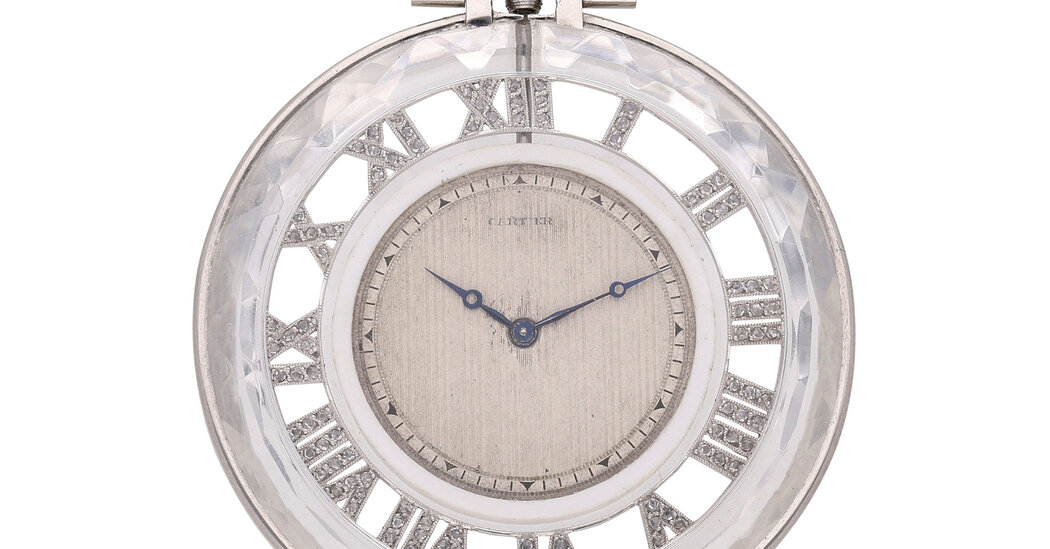Decorative gems have adorned watches for centuries. But, beyond diamonds and the classic trinity of rubies, emeralds and sapphires, a colorless variety of quartz called rock crystal actually is the stone used most often in horology.
Yet, “as a material, not a lot of people know about it,” said Tom Heap, deputy director and head of watch sales at Sotheby’s London. “But I think with the way we’re seeing watch brands operate nowadays, you’re seeing a return to low production and almost a kind of historical watchmaking. It’s like a painter looking back at the old masters.”
Van Cleef & Arpels and Chanel were among the brands to showcase new timepieces set with rock crystal at Watches and Wonders Geneva, the weeklong trade show ending Monday — creations that highlighted not only the brands’ stonecutting and setting know-how, but which also showed off the unusual features of this less familiar gemstone.
Formed of oxygen and silicon, two of the most abundant elements in the Earth’s crust, rock crystal takes its name from the ancient Greek word krustallos, meaning “frozen ice,” and has long been admired for its glass-like properties.
Some of the earliest examples of decorative rock crystal can be traced to ancient Mesopotamia, Egypt and Persia, where it was used in ornaments including vessels and figurines, according to Helen Molesworth, a gemologist and the senior curator of jewelry at the Victoria and Albert Museum in London.
The ancient Romans carved images and other sacred symbols into the stone, creating seals and intaglios. “I just saw that there’s even a Roman rock crystal spoon in the Metropolitan Museum of Art in New York, which is just gorgeous,” Ms. Molesworth said. “And then it had huge popularity, not so much a revival, just massive popularity, in the 10th and 11th centuries with Fatimid carved vessels and beautiful Egyptian carvings.” (The Fatimid dynasty dominated North Africa and later much of the Middle East.)
In more modern times, rock crystal was championed in the early 1900s by Cartier, which created the first mystery clocks, timepieces whose hands appeared to float freely over a dial typically encased in rock crystal.
“Because of this kind of transparency, rock crystal has been associated with things like purity, air and water throughout time,” Ms. Molesworth said. “It also has practical applications so it’s perfect for all of these kinds of objects because it’s imbued with significance.”
This week, that transparency was showcased in the Lady Arpels Nuit Enchantée watch by Van Cleef & Arpels, presented at Watches and Wonders Geneva and one of two new additions to the brand’s Extraordinary Dials collection of limited-edition timepieces.
The 41-millimeter white gold model featured a dial of rock crystal, totaling 11.8 carats, with rose gold indexes. The watch, made with traditional métiers d’art techniques such as marquetry, along with plique-à-jour, façonné and grisaille enameling, shows a fairy’s visit to a moonlit cave — the cave and the bezel encrusted with 25 yellow sapphires, 11 carats of purple sapphires and 280 round white diamonds.
Rainer Bernard, director of research and development of watches for Van Cleef & Arpels, said the company has used rock crystal since its founding in 1906 on luxury objects such as platinum and sapphire pocket watches and Art Deco table clocks. The allure, he noted, lies in the stone’s soft luster and durability.
“It’s actually a nice material to work with,” he said. “It has a hardness of seven, so it’s not brittle, like opal, for example.” He was referring to the Mohs hardness scale, which measures a mineral’s resistance to scratching on a scale of one to 10, with 10 being the hardest. “There are no specific precautions to take, you can work it really well.”
For the Lady Arpels Nuit Enchantée watch, traditional lapidary tools were used on the crystal to make an octagonal emerald cut with a double facet at the lower edge, to create a reflective surface. “Because of the cut, it looks like the indexes hover in the air and this creates volume,” Mr. Bernard said. “This actually creates play with the light and was important as an element of our cave.”
Chanel, which presented its first collection of watches in 1987, also experimented with rock crystal this year for its Crystal Lion Long Necklace, introduced at Watches and Wonders as part of the brand’s Time of the Lion collection.
Taking inspiration from the chandelier in 31 Rue Cambon, the house’s flagship in Paris, the necklace’s quartz-powered timepiece features a yellow gold pendant in the shape of a lion’s head, with a tassel made of rock crystal. The piece is accented with 19 carats of brilliant-cut diamonds and a princess-cut center diamond.
Occasionally rock crystal has made the leap into high jewelry, too. Frédéric Boucheron, who founded his namesake Parisian jewelry house in 1858, was an early pioneer in pairing rock crystal with diamonds.
Claire Choisne, Boucheron’s creative director since 2011, often uses the stone, too, most recently in the Power of Couture, a high jewelry collection presented in January that matched rock crystal with white diamonds, and showcased the stone in the form of tubes, chevrons and engraved medallions.
For example, the Tricot choker used five strands of sandblasted rock crystal, finished with diamond-set chevron links and a central button featuring a 2.01-carat diamond.
Another necklace, the Noeud, featured 435 baguette-cut rock crystals mounted in a white gold framework shaped like a bow. The necklace, with a 4.05-carat pear-shape diamond at its center, may be transformed into a brooch or a shoulder adornment.
“Rock crystal, which symbolizes wisdom and foresight, is one of my favorite stones,” Ms. Choisne wrote in an email. She noted that, while the stone “was long not considered precious in high jewelry, Boucheron has celebrated it for centuries.”
“I also believe that the monochrome aspect of rock crystal brings style and modernity to the jewelry,” she added.
Will the crystal continue to be popular in high watchmaking and jewelry?
“The clarity of rock crystal as a quartz is obviously its attraction,” said Ms. Molesworth, who noted that its appearance on recent watch models was a reflection of its many decorative and practical uses, qualities she expects will continue to attract watchmakers.
“It’s large, it’s accessible and it’s carvable,” she said. “So you’ve got a perfect combination of various different qualities in this material.”
Sumber: www.nytimes.com












